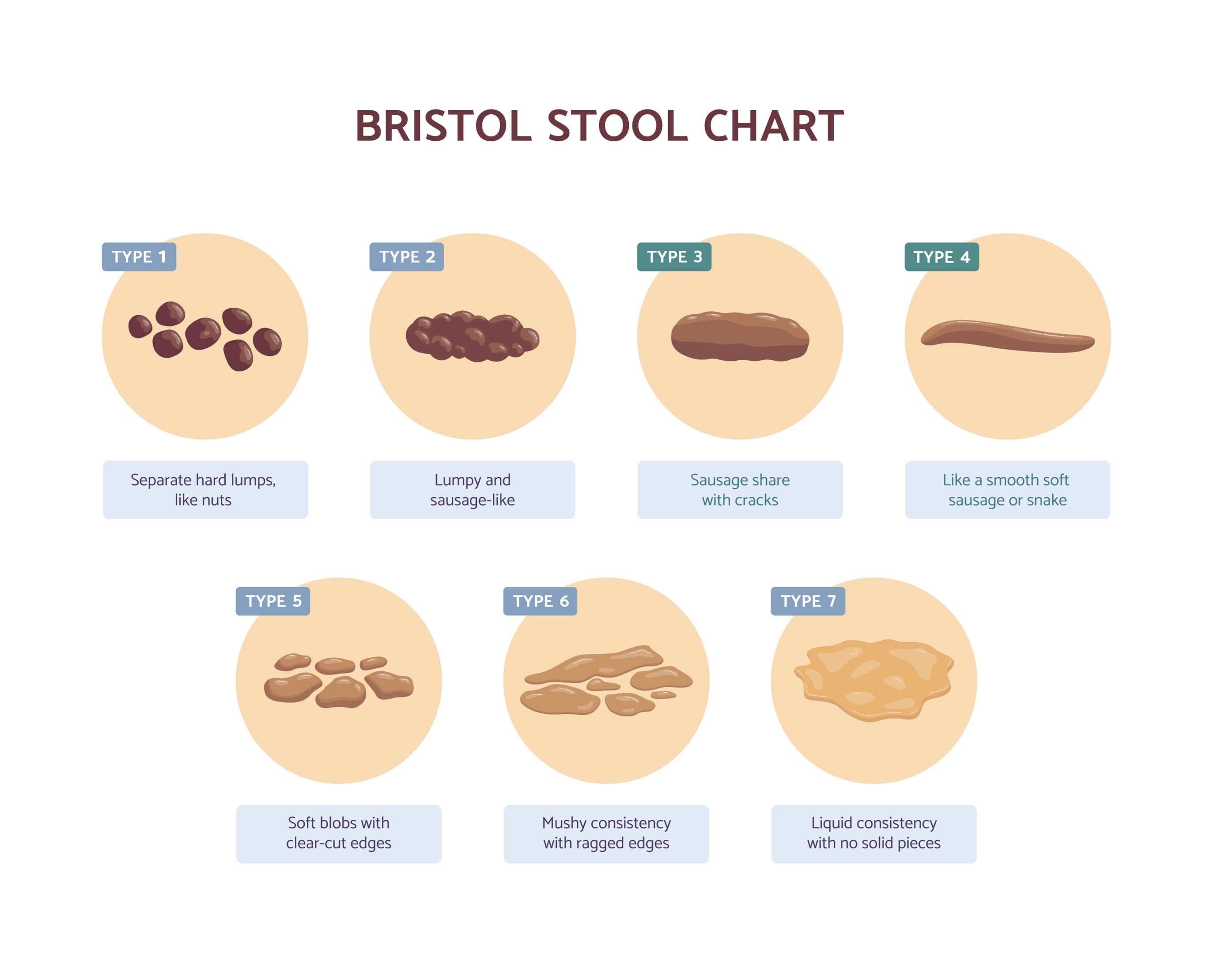
The Bristol Stool Chart helps you read what your poop says about your gut. This guide walks you through the seven types and what to do next.
I lived with Crohn’s for 16 years and have coached people on rebuilding their gut health. I use simple tools like this chart to track progress and build lasting gut health.
What the Bristol Stool Chart Shows
The Bristol Stool Chart is a simple way to describe stool shape and consistency across seven types. Types 3 and 4 are the goal for easy, comfortable bowel movements most of the time.
Use it to spot patterns, track changes, and talk clearly with your GP about your bowel habits. It is a quick visual check, not a diagnosis.
| Type | Description | Symptom |
| Type 1 | Separate hard lumps, like nuts. Hard to pass. | Severe Constipation |
| Type 2 | Lumpy and sausage like. Hard to pass. | Mild Constipation |
| Type 3 | Sausage shaped with cracks. | Normal |
| Type 4 | Smooth, soft sausage or snake like. | Normal |
| Type 5 | Soft blobs with clear cut edges. | Mild Diarrhoea |
| Type 6 | Mushy pieces with ragged edges. | Diarrhoea |
| Type 7 | Liquid with no solid pieces. | Severe Diarrhoea |
7 Different Types of Poop
Type 1: Severe constipation
Type 1 looks like separate hard lumps that are tough to pass.
It often means stool stayed in the colon too long with not enough fluid or fibre.

Type 2 - Mild constipation
Type 2 looks like a lumpy sausage and is also hard to pass.
It points to slow transit and extra water being absorbed in the colon.

Type 3 - Normal
Type 3 is sausage shaped with cracks on the surface. It is well formed and should pass without straining.

Type 4 - Ideal
Type 4 is smooth and soft, like a snake. This is the ideal form for most people.

Type 5 - Lacking fibre / Mild diarrhoea
Type 5 shows soft blobs with clear cut edges. It can mean you need more fibre to firm things up.

Type 6 - Diarrhoea
Type 6 looks fluffy and mushy with ragged edges.
Food is moving too fast through the gut and may be due to infection, medication, or a digestive issue.

Type 7 - Severe diarrhoea
Type 7 is watery with no solid pieces.
Persistent cases can relate to infections like a virus or conditions such as Crohn’s disease.

How to Use the Bristol Stool Chart
Look for trends over a week rather than one visit to the loo. Aim for the middle of the scale most days.
If you sit in the constipation or diarrhoea ranges often, try simple lifestyle tweaks. Speak to your GP if it keeps going.
Take brief notes and bring them to appointments. This helps with assessment and care.
Simple Adjustments to Get to Types 3–4
Eat more fibre rich foods and drink water through the day. Small, steady changes work best.
Keep up gentle movement to support gut motility. Even a daily walk helps.
Create calm routines that are kind to digestion. Unhurried meals and a relaxed morning can make a difference.
You can also swap some coffee for a calming plant tea like Cosmic Hue. It is caffeine free and supports hydration as part of your daily routine.
What Poop Colour Can Tell You
Colour as well as texture can give useful clues to tell if your poop is healthy.
| Colour | What It Means |
| Brown | Typical and expected. Usually means digestion is on track. |
| Black | Often from iron tablets, bismuth medicines, or liquorice. Without these, a dark stool can signal bleeding higher in the gut. |
| Green | Common after lots of leafy foods. Can also show faster transit with more bile left in the stool. |
| White | A white or pale stool suggests little bile reaching the bowel, sometimes due to a blocked duct. |
| Red | May come from bleeding low in the bowel or haemorrhoids. Or could just be you had some beetroot or other red foods. |
| Yellow | Greasy, yellow stool points to poor fat absorption. Bright yellow with other symptoms can be linked to some infections. |
The normal brown colour is expected, even with a slight hint of green.
Beetroot and some red foods can tint your poop red or purple for a short time.
However, most times if you poop is not brown then it is best to seek medical advice.
When to Speak With a Healthcare Professional
Get help if constipation or diarrhoea sticks around. Ongoing change needs attention.
Contact your GP if you notice blood in the stool or pale, chalky colours or signs of dehydration.
Seek advice for any bowel changes that do not settle. Trust your gut and ask early.
Conclusion
Types 3 and 4 are the sweet spot for most people.
Use the Bristol Stool Chart as a simple feedback tool and make small daily adjustments.
If you want a gentle daily ritual to support your gut, try Cosmic Hue. I drink it every morning, as well as thousands in our community.
Author: Manny is the founder of Fifth Ray and a certified Gut Health Coach. After battling Crohn's Disease for 16 years, he transformed his gut health through plant-based healing. His story has been featured on BBC, ITV, and Daily Mail.
Please note this information is for educational purposes only, not medical advice. Cosmic Hue is not intended to diagnose, treat, cure, or prevent any disease. Always consult your healthcare provider before making changes to your health routine.

